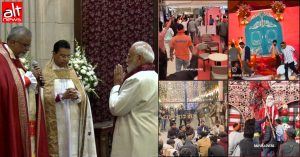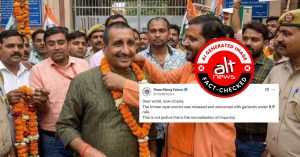Since August 19, soon after psephologist Sanjay Kumar, a professor with the Delhi-based Centre for the Study of Developing Societies (CSDS), retracted and apologised for sharing erroneous data on the 2024 Maharashtra elections, several Bharatiya Janata Party (BJP) leaders, media outlets and X users jumped to rubbish Congress leader Rahul Gandhi’s claims of irregularities in electoral rolls and ‘Vote Chori’.
The development comes amid growing scepticism of the Election Commission of India (EC) after Rahul Gandhi highlighted several irregularities in poll data, claiming they pointed to a compromised poll panel and jeopardised free and fair elections.
At a press conference on August 7, he flagged glaring irregularities in the voter list of Karnataka’s Mahadevapura constituency in Bengaluru, raising doubts of vote theft or “Vote Chori“. In February and June this year, Gandhi had claimed there was “industrial-scale rigging” in the Maharashtra Vidhan Sabha elections too. Opposition leaders, including Gandhi, have also questioned the EC’s move to undertake an intensive revision of electoral rolls in Bihar right before the state is headed to polls, suggesting that such exercises done hurriedly could introduce more errors than weeding them out.
However, after Kumar’s slip-up, the BJP and its allies have challenged and discredited Gandhi’s claims of voter manipulation, arguing that Gandhi’s assertions were based on ‘inaccurate’ CSDS data and hence baseless.
As the story will elucidate, Kumar retracting his posts does not invalidate Rahul Gandhi’s allegations of vote manipulation. First, claims that Rahul Gandhi used ‘CSDS data’ do not hold because only the Election Commission (EC) maintains granular data on voters and electors. In fact, Kumar’s claims were also based on information from the poll body. The error was that he mistakenly compared numbers from different constituencies. Secondly, the claims made by Gandhi and those retracted by Kumar are distinctly different, though both deal with Maharashtra. While Rahul Gandhi’s claims were regarding anomalies in votes polled throughout the state, Kumar’s focus was on four specific constituencies.
What Sanjay Kumar Posted and Took Down
Sharing voter data from four Maharashtra Assembly seats — Ramtek, Devlali, Nashik West and Hingna — Kumar had, on August 17, highlighted an unusual difference in voter numbers between the Lok Sabha and Vidhan Sabha elections that were just five months apart.
According to data shared by Kumar, in Ramtek and Devlali, there was a significant decline (over 35%) in the number of voters between the general election in June and the state polls in November. The trend in Nashik West and Hingna was the opposite. From the general elections in June, there was an over 40% rise in the number of voters in the state elections in November. But Kumar soon took down these X posts. On August 19, he posted that errors while comparing data in different rows had resulted in him presenting incorrect information.
What Rahul Gandhi Alleged
At his August 7 press conference, Rahul Gandhi focused on Karnataka’s Mahadevapura constituency in Bengaluru Urban. In his presentation, he said there were several manipulations in the voter list during the 2024 Lok Sabha elections and accused the poll panel of aiding ‘vote theft’.
He pointed out irregularities such as duplication of voters with the same and different ID numbers, electors registered with incomplete, incorrect or made-up addresses, and an unusually high concentration of voters in certain houses. Corroborating this with on-ground investigation, Gandhi highlighted that it took his team months to find these anomalies from troves of non-machine-readable data provided by the EC.
In June, he had outpointed that there was an unusually high number of electoral registrations just before the 2024 Maharashtra assembly elections. From his column in The Indian Express:
Election Commission (EC) data show that the number of registered voters in Maharashtra in the 2019 Vidhan Sabha elections was 8.98 crore, which rose five years later to 9.29 crore for the May 2024 Lok Sabha elections. But a mere five months later, by the November 2024 Vidhan Sabha elections, the number had leaped to 9.70 crore. A crawl of 31 lakh in five years, then a leap of 41 lakh in just five months. So incredible was this leap that the registered voter total of 9.70 crore was even greater than the 9.54 crore adults in Maharashtra, according to the government’s own estimates.
In February, Rahul Gandhi had made related claims. Speaking in Parliament (February 3), he had said that 70 lakh more votes were polled during the 2024 Vidhan Sabha elections compared to the Lok Sabha polls, which was the margin of difference with which the BJP won. Later, at a party press conference (on February 7), he claimed that more number of electors had been added in Maharashtra in the five months between the Lok Sabha elections and the Maharashtra Vidhan Sabha elections in 2024 (39 lakh) than in the five years between the Maharashtra Vidhan Sabha polls 2019 and the Lok Sabha elections 2024 (32 lakh).
BJP Rubbishes Claims
After the CSDS co-director took down his X posts, BJP leaders jumped in to allege that Rahul Gandhi’s claims were based on CSDS data and were thus invalid.
Maharashtra chief minister Devendra Fadnavis went on to call Gandhi a “serial liar” and asserted that the “truth has come before the public”.
#WATCH | Mumbai: Maharashtra CM Devendra Fadnavis says, “This is a fact that data was given by CSDS, and based on that data, Rahul Gandhi had made allegations on the Election Commission, and also he had accused us of our legitimately elected government. Today, CSDS has tweeted on… pic.twitter.com/IHYmHasXK8
— ANI (@ANI) August 19, 2025
On X, BJP IT cell chief Amit Malviya wrote: “The very institution whose data Rahul Gandhi leaned on to defame the voters of Maharashtra has now admitted that its figures were wrong…” Sharing a collage of Sanjay Kumar’s deleted tweet alongside his apology, Malviya urged Gandhi to apologise “to the people of India for his callous and regressive politics.” (Archive)
The very institution whose data Rahul Gandhi leaned on to defame the voters of Maharashtra has now admitted that its figures were wrong — not just on Maharashtra, but even on SIR.
Where does this leave Rahul Gandhi and the Congress, which brazenly targeted the Election… pic.twitter.com/4o99YDvsMx
— Amit Malviya (@amitmalviya) August 19, 2025
BJP spokesperson Gaurav Bhatia, in a press conference on August 19, also claimed that Rahul Gandhi’s allegations of voter list manipulation by the EC were based on data from the CSDS.
Bhatia noted that Gandhi’s claims shifted over time. According to him, Gandhi first alleged there was an increase of about 70 lakh voters between Lok Sabha and Vidhan Sabha elections in Maharashtra (on February 3 in Parliament). Then, at a press conference on February 7, the Opposition leader cited a 39 lakh rise in electors and by July 9, Gandhi said the difference in the number of voters between the two elections swelled to 1 crore.
‘Discrepancy in Rahul Gandhi’s Numbers’, ‘Flawed Data’
Not just BJP’s Bhatia but NDTV journalist Padmaja Joshi also pointed out discrepancies in Gandhi’s figures. In her show on August 19, referring to Sanjay Kumar’s slip-up, the journalist noted that Gandhi had cited four different numbers on separate occasions — 70 lakh, 39 lakh, 40 lakh, and 1 crore — as the increase in ‘magic voters’. The same day, NDTV’s Shiv Aroor, on his show “From ‘Chori’ to ‘Sorry'”, asked ‘Was this just a one-off innocent error or does this call into question the entire edifice of proof of rigged election that Rahul Gandhi is separately projecting?”
#IndiaMatters with @ShivAroor | Sanjay Kumar apologises for erroneous data about Maharashtra voter increase. But that’s not the only allegation.
Here is what LoP Rahul Gandhi claimed about Maharashtra ‘vote chori’ and this is what the facts are@PadmajaJoshi pic.twitter.com/ZtHJiLgD7h
— NDTV (@ndtv) August 19, 2025
Anchors from several other news outlets claimed that Gandhi had used CSDS data.
India TV editor-in-chief Rajat Sharma targeted the Leader of Opposition: “Today Rahul Gandhi has to face a big embarrassment…the data that he is using to continuously target the Election Commission on the surge in voters in Maharashtra, is under question.” Sharma aired Gaurav Bhatia’s press conference, where he had raised the same allegations, without going into specifics of the discrepancies.
Republic editor Arnab Goswami repeatedly played clips of Rahul Gandhi from the August 7 press conference in his show to suggest that Gandhi also used “incorrect” CSDS data. “So who do you believe? The psephologist who turned back on his own numbers or the Congress party, which draws large inferences based on this data?” he asked. “Is either of them telling you that the large claims being made about the Indian electoral system should not be believed based on data, which is itself suspect? If it is all believed to be a lie and all lies fall flat, then how can you make these big inferences about my nation’s democracy?”
On X, several BJP-supporting handles, including @rishibagree and @MrSinha_, claimed that Rahul Gandhi’s allegations against the Election Commission of India were based on data from CSDS.
Did Rahul Gandhi Use CSDS Data?
After Sanjay Kumar posted the erroneous data, some Congress leaders used Kumar’s figures to validate their ‘Vote Chori‘ campaign. Among those was Pawan Khera, chairman of the party’s media and publicity department, who shared a graph based on Kumar’s data and later deleted it without any explanation. Below is a screenshot of his now-deleted X post.
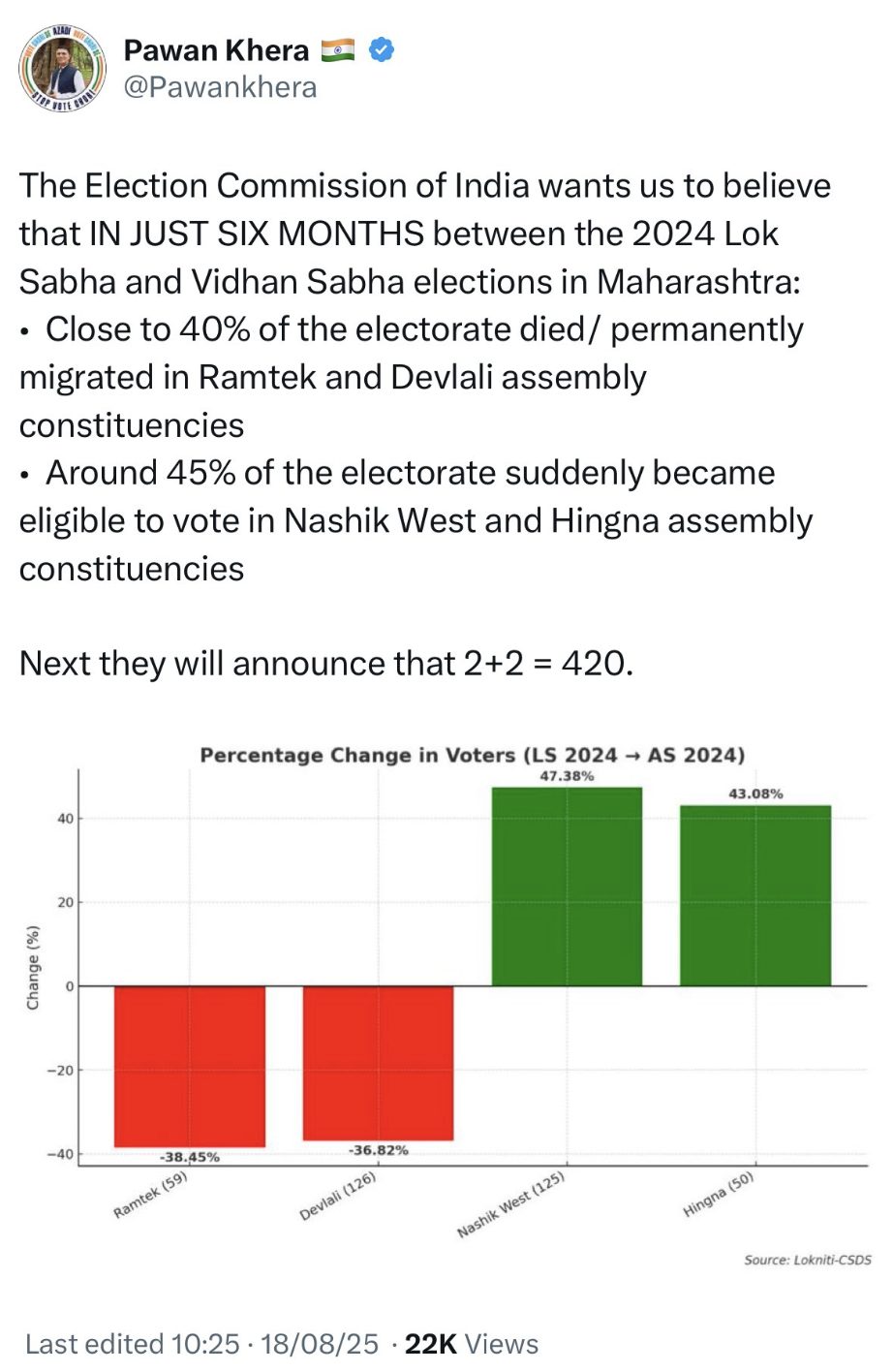
However, Alt News’s analysis found that allegations by Rahul Gandhi were not based on the incorrect information in the retracted post by the CSDS professor. Note that Gandhi had first shared data on anomalies in voter turnouts in February, months before the launch of the ‘Vote Chori‘ campaign. However, only after the CSDS psephologist retracted his post were the Opposition leader’s claims linked to their data and discredited.
As mentioned before, he did give different numbers — 70 lakh, 39 lakh or 40 lakh, and 1 crore — when talking about the increase in the number of voters between the two elections. Let’s look at each of these separately.
’70 lakh’
On February 3, Rahul Gandhi told the Lok Sabha that there was an increase of 70 lakh new voters in Maharashtra between the general and state elections that were five months apart. In his words, “Almost 70 lakh new voters suddenly arrived between Lok Sabha and Vidhan Sabha.”
It is pertinent to note here that Gandhi was not referring to the net addition to the list of electors, but the difference in voter turnout or votes polled between the two elections. We know this because he also said that the additional votes went to the BJP, which made it clear he was referring to votes polled.
Let us compare Gandhi’s data to figures released by the EC.
According to the official handbook of the 2024 Lok Sabha elections (Chapter 7), released by the chief electoral officer (CEO), the total number of votes polled in Maharashtra was 5.7 crore.
Official data by the Maharashtra CEO for the total number of votes polled in the state during the Vidhan Sabha polls stood at 6.4 crore.
The difference between the votes polled or the voter turnout between the two elections was 69 lakh. To put it simply, 69 lakh more people voted in the Vidhan Sabha polls compared to the Lok Sabha polls. This figure was possibly rounded off by Gandhi to 70 lakh votes.

Interestingly, in the Lok Sabha elections, the National Democratic Alliance (NDA), comprising the BJP, Ajit Pawar-led Nationalist Congress Party and Eknath Shinde-led Shiv Sena, received over 2.4 crore votes. In the assembly elections, they netted 3.1 crore votes.
In contrast, the Maha Vikas Aghadi alliance (MVA), comprising Congress, Sharad Pawar-led Nationalist Congress Party and the Uddhav Thackeray faction of the Shiv Sena, amassed 2.5 crore votes in the Lok Sabha elections and 2.1 crore votes in the Vidhan Sabha polls.
This means that the NDA got over 67 lakh more votes in the state polls than in the general elections, which is fairly close to the number of additional voters who voted in the state polls (69 lakh as highlighted above). Meanwhile, the MVA lost nearly 33 lakh votes in the state elections. Gandhi continued to highlight in subsequent public addresses that, on several occasions, the number of extra votes in the latter elections went to the BJP or NDA’s kitty.
’39 or 40 lakh’
On February 7, Rahul Gandhi, along with Nationalist Congress Party (Sharad Pawar) MP Supriya Sule and Shiv Sena (UBT) MP Sanjay Raut, held a press conference detailing anomalies in voter lists in Maharashtra.
The main points raised by Gandhi were:
- More voters added in five months compared to five years ago: In five years, between the 2019 Maharashtra Vidhan Sabha elections and the 2024 Lok Sabha elections, there was an increase of 32 lakh electors. However, in the five months between the 2024 Lok Sabha elections and the 2024 Maharashtra Vidhan Sabha elections, there was a 39 lakh increase in electors. “Who are these additional voters? Where were they and where have they come from?” asked Gandhi.
- Additional votes went to BJP: Taking the example of the Kamthi constituency in Maharashtra, Gandhi said that the Congress coalition got approximately the same number of votes in last year’s Lok Sabha (1.36 lakh) and the Vidhan Sabha elections (1.34 lakh). Between the two elections, 35,000 electors were added in this constituency. BJP received 1.75 lakh votes in the Vidhan Sabha elections compared to 1.19 lakh in the Lok Sabha. According to Gandhi, “most of the voters that provided the BJP with the victory came from this increase” in the number of voters between the two elections in the Kamthi constituency.
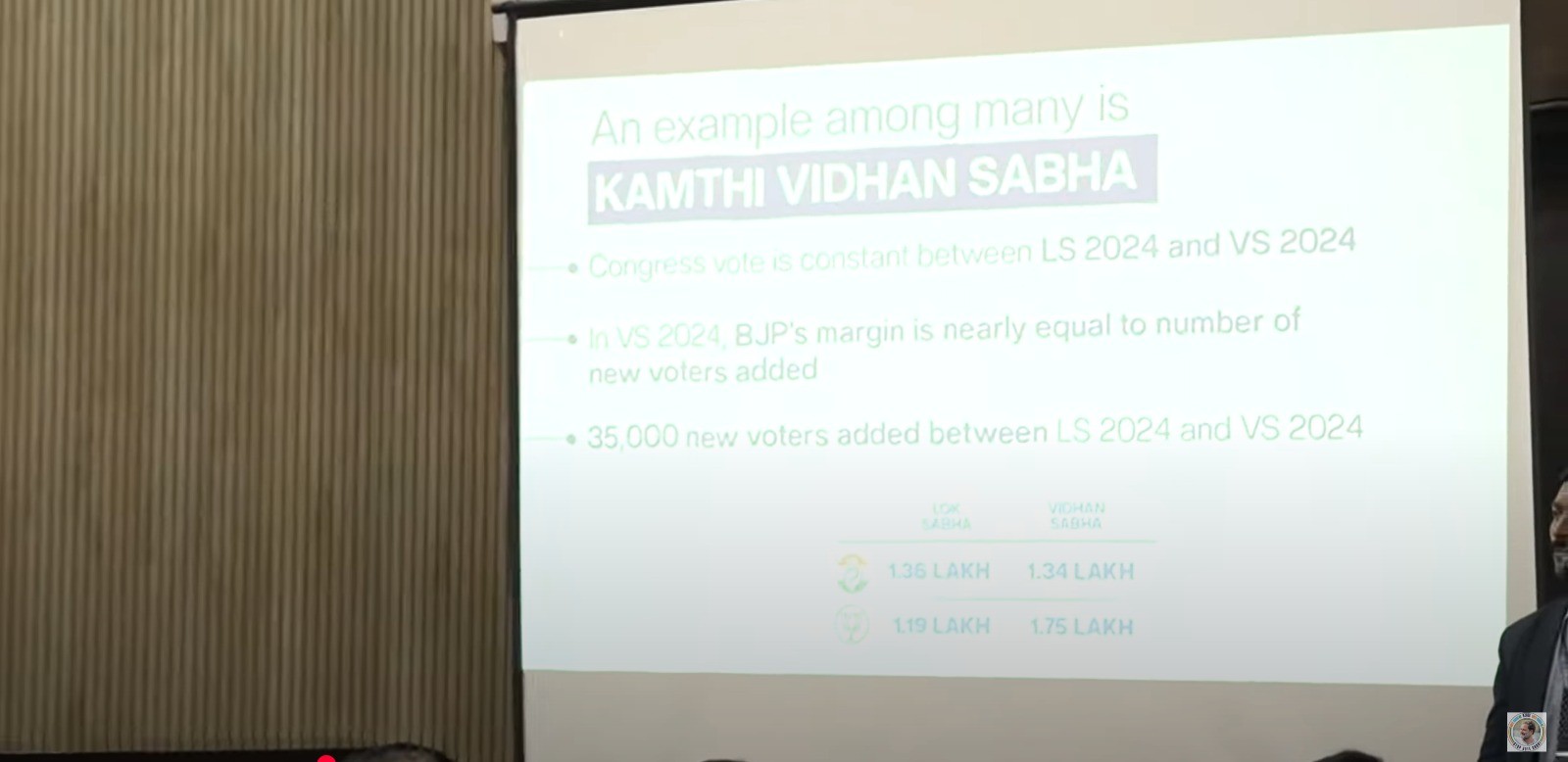
Still from the February 3rd press conference held by Rahul Gandhi, Supriya Sule and Sanjay Raut
3. More voters than adult population: Gandhi said that Maharashtra’s adult population was 9.54 crore, but the EC had listed 9.7 crores total electors in the state. “This means the EC is saying that there are more voters than the adult population in Maharashtra. How can this happen?” he asked. When he was asked the source of the data on adult population, he said it was from the Union ministry of health and family welfare (MoHFW).
We looked at each of these data points closely.
More voters added in five months compared to five years ago
Gandhi claimed around 32 lakh new electors were registered between 2019 VS polls and 2024 LS polls. However, between 2024 LS polls and 2024 VS polls, there was a 39 lakh increase in the number of electors.
Data compiled from Maharashtra CEO’s district-wise elector lists showed that total electors in the 2019 assembly elections stood at 8.98 crore. (Alt News added the number of electors in each district to arrive at this number.) Meanwhile, data from the EC handbook for the 2024 Lok Sabha elections listed total electors at 9.31 crore in Maharashtra. The difference between the two is around 32 lakh. Thus, Gandhi’s claim closely aligns with official EC data.

Data by the Maharashtra CEO put the total number of electors in the 2024 Lok Sabha elections as 9.29 crore. The variation is owing to two separate sources for the electoral count by the Election Commission and the Maharashtra CEO.
If this figure is taken into account, the difference between the number of electors between the 2019 assembly elections and the 2024 general elections changes to 31 lakh.

Either way, the numbers stack up with Rahul Gandhi’s estimates.
For the 2024 general elections, the total number of electors in Maharashtra, according to the EC handbook, was 9.31 crore. According data from the Maharashtra CEO, the total number of electors before the 2024 assembly elections stood at 9.7 crore.
The difference between the two is about 39.6 lakh. Thus, Rahul Gandhi’s data, again, aligns with EC figures.

Again, owing to separate electoral data maintained by the state election officer and EC, we found that the number of electors before the 2024 Lok Sabha elections was 9.29 crore, according to the Maharashtra CEO figures.
In that case, the difference in the number of electors between the two polls rises to 40.8 lakh.
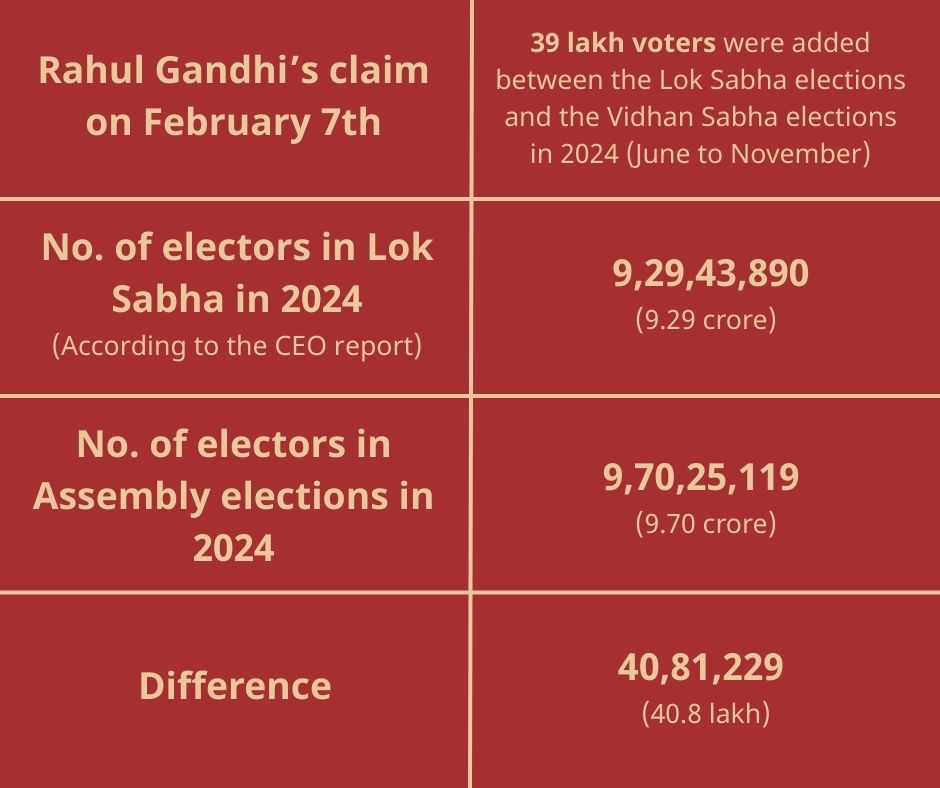
The EC, in a letter to the Congress dated December 24, 2024, stated that the net number of electors added between the 2024 general and assembly elections in Maharashtra was 40.81 lakh.
Thus, these figures also align with data shared by the Election Commission.
Additional votes went to BJP
Alt News accessed the breakdown of the Lok Sabha (2024) votes for the Kamthi constituency by the EC. Based on this, Rahul Gandhi’s data matches EC data. Form 20 for the Ramtek LS constituency, under which Kamthi falls, shows that INC candidate Shyamkumar Daulat Barve received approximately 1.36 lakh votes while the Shiv Sena (Shinde faction) candidate, Raju Deonath Parve, amassed approximately 1.19 lakh votes in Lok Sabha.
The assembly elections results from Kamthi showed that Chandrashekhar Krushnarao Bawankule from the BJP received 1.74 lakh votes while the INC candidate got 1.34 lakh votes.
Gandhi also claims that 35,000 voters were added between the Lok Sabha elections in June and the assembly elections in November 2024 in Kamthi. According to data from the Maharashtra CEO published in October 2024, before the state elections, the total number of electors was 5 lakh. However, the number of electors in Kamthi just before the Lok Sabha elections stoof at 4.66 lakh, according to the EC’s elector count. The difference between these two figures is 35,539, possibly rounded off by Rahul Gandhi to 35,000.
More voters than adult population
Alt News checked the MoHFW website but did not find this data on it. Thus, we were unable to corroborate this claim.
‘1 crore’
Gandhi had claimed at least twice — in Bengaluru and in Bihar’s Sasaram — that in the five months between Lok Sabha and Vidhan Sabha polls in Maharashtra last year, total number of votes polled went up by 1 crore, and that all these extra votes had gone to the BJP.
These claims do not align with EC data. We have written about this in detail here. According to our analysis, the number of additional votes polled stood at a little over 69 lakh.
Rahul Gandhi’s Claims Not Based on CSDS Data
As our analysis shows, most of the data cited by the Congress leader is in line with numbers shared by the Election Commission.
Also, at no point during his press conferences did Gandhi attribute any of the data he presented to CSDS. In fact, he categorically mentions that his claims were based on EC figures and that his team studied voter lists and voting patterns in detail. In his August 7 press conference, too, Rahul Gandhi reiterated that his team had to sift through data that was over seven feet in height, individually, just to examine one constituency in Karnataka. He said it took his team of 30-40 people six months to do this for one constituency since the EC did not provide machine-readable data.
Furthermore, the CSDS does not publish election data directly. Its primary study, the Lokniti-CSDS survey called ‘National Election Studies, mainly gauges public opinion on key issues before and after each Lok Sabha election. During an interview with NDTV journalist Shiv Aroor, while explaining his mistake, CSDS co-director Sanjay Kumar said that he was also referring to EC data to compare the voter figures in the constituencies. However, he mistakenly compared constituency 125 with 124 (Nashik West with Nashik Central). Kumar denied any political motive behind this.
Credit for featured image: Facebook/ @IndianNationalCongress
Independent journalism that speaks truth to power and is free of corporate and political control is possible only when people start contributing towards the same. Please consider donating towards this endeavour to fight fake news and misinformation.


